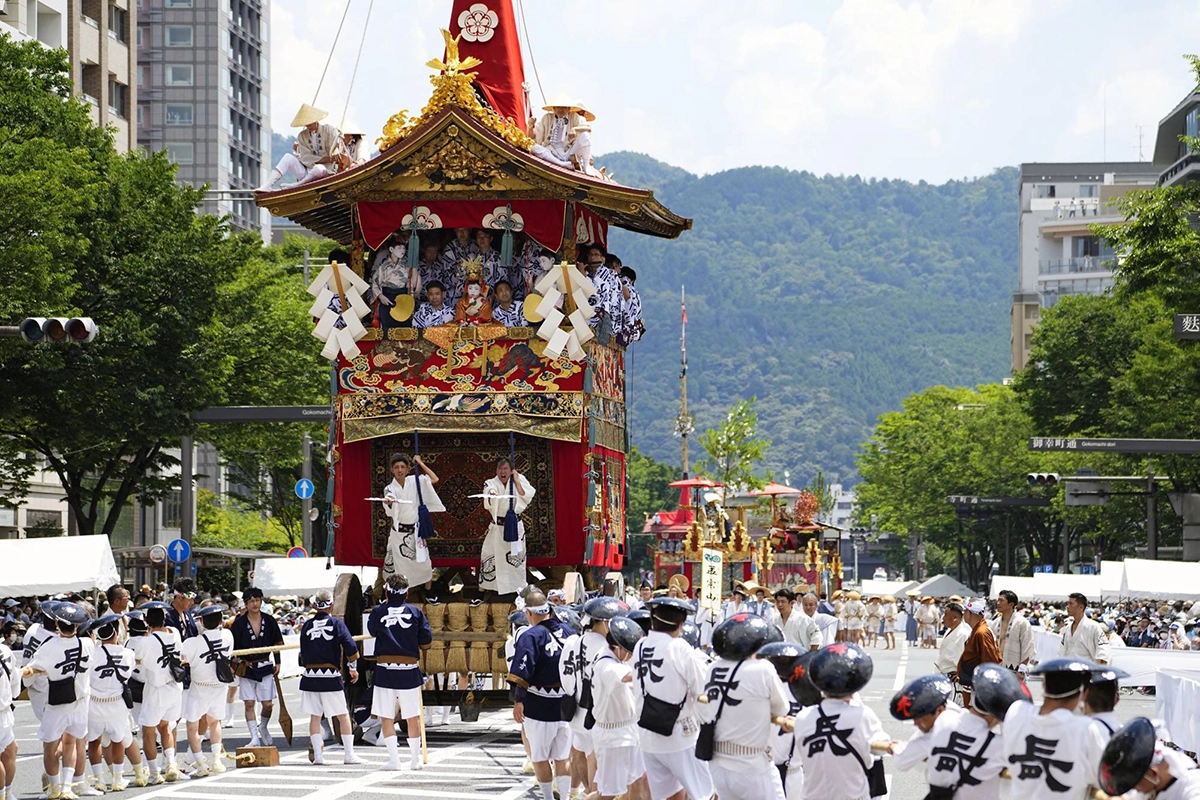We visited many festivals in Japan. This article will encourage you to embark on a vibrant journey through Japan, a land where ancient traditions and modern spectacles blend seamlessly. From the pink blossoms of spring to the fiery fireworks of summer, Japanese festivals (matsuri) offer a unique glimpse into the heart and soul of this fascinating country. This guide will introduce you to the must-see festivals that are not just celebrations but a tapestry of Japan’s rich culture and history.
An Unforgettable Festivals Through Tradition and Celebration
Hanami: The Cherry Blossom Festival (Spring)
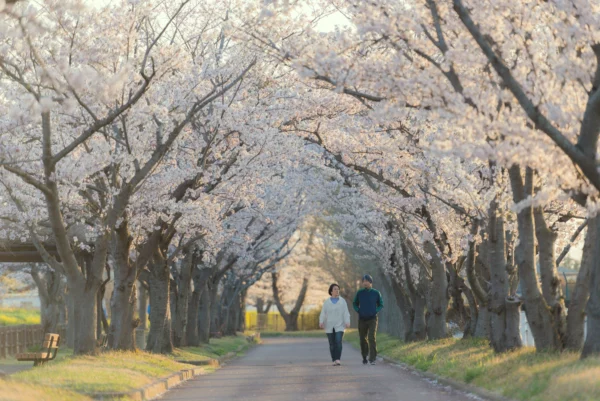
Hanami, the time-honored Cherry Blossom Festival, symbolizes the beauty of nature and the ephemerality of life, a concept central to Japanese culture. As the cherry blossoms (sakura) herald the arrival of spring, a palpable excitement fills the air across Japan. The festival’s history dates back over a thousand years, evolving from aristocratic flower-viewing traditions to become a nationwide celebration open to everyone.
The cherry blossom’s fleeting beauty, blooming en masse for just a week or two before falling, has long been a metaphor in Japanese poetry and art for the transient nature of life. This has given the Hanami festival a poignant depth beyond its surface beauty. People from all walks of life gather under the blooming sakura trees, laying down tarps and enjoying picnics with friends, family, or coworkers. The joyous atmosphere is palpable, with laughter, music, and the sharing of food and drink, including traditional festival fare like dango (sweet rice dumplings) and bento boxes, as well as seasonal sakura-flavored treats.
Hanami is not just limited to daytime. Yozakura, the viewing of cherry blossoms at night, offers a different, equally enchanting experience. Parks and temples hang paper lanterns that illuminate the pink and white petals, creating a surreal and romantic ambiance. This tradition allows for a quieter, more reflective experience of the sakura’s beauty.
While popular spots like Tokyo’s Shinjuku Ryoen National Garden and Hamarikyu Gardens, Kyoto’s Kiyomizu-dera, Heian Shrine, and Philosopher’s Walk, and Odawara Castle in Kanagawa Prefecture draw large crowds, the entire country is dotted with cherry trees, making Hanami a truly national event. From urban parks to remote mountain temples, each location offers a unique way to experience this quintessential Japanese festival.
Aoi Matsuri: Kyoto’s Ancient Festival (Spring)
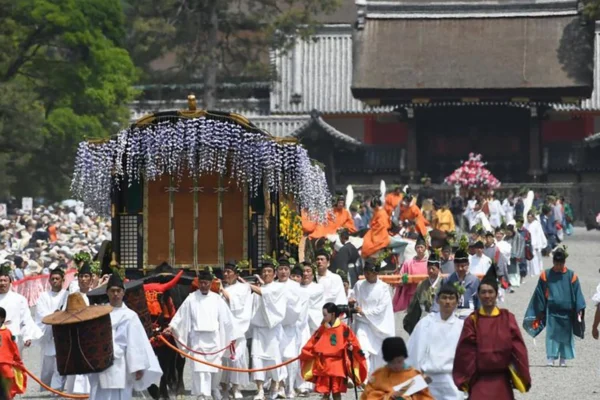
The Aoi Matsuri, or Hollyhock Festival, held annually on May 15th in Kyoto, is one of Japan’s three great imperial festivals. Dating back to the 7th century, this festival is known for its elegance and refined beauty, reflecting the aristocratic culture of the Heian Period. It’s named after the aoi (hollyhock) leaves used to decorate the procession and the shrines involved.
The festival originated as a ritual to appease the gods for protection from natural disasters and to ensure a bountiful harvest. Today, it remains a significant cultural and religious event, involving the Kamigamo and Shimogamo Shrines. The highlight of Aoi Matsuri is the grand procession, which reenacts the imperial envoy’s journey to the shrines. Over 500 people, dressed in exquisite Heian Period costumes, participate in this parade, making it a spectacular historical reenactment.
Leading the procession are riders on horseback, followed by a series of ox-drawn carts, palanquins, and participants on foot. The most awaited moment is the appearance of the Saio-dai, a woman chosen to represent the imperial princess, dressed in a stunning twelve-layered kimono and riding in a palanquin. The procession route, stretching over several kilometers from the Imperial Palace to the shrines, is lined with spectators, many dressed in traditional kimonos, adding to the festive atmosphere.
Aoi Matsuri offers a glimpse into Japan’s ancient court life and religious traditions. The meticulous attention to historical detail in costumes, the use of hollyhock leaves, and the solemnity of the rituals performed at the shrines all contribute to the festival’s unique charm. It’s a festival that not only celebrates Kyoto’s rich history but also showcases the enduring connection between Japan’s past and present.
Gion Matsuri: Kyoto’s Pride (Summer)
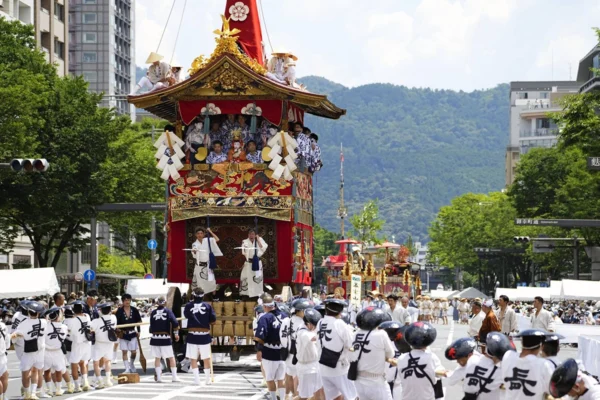
The Gion Matsuri, spanning the entire month of July, is not only a grand spectacle but a living museum of Kyoto’s rich history. Originating in 869 AD as a religious ceremony to appease the gods during an epidemic, it has evolved into one of Japan’s most elaborate festivals. Central to this celebration is the awe-inspiring Yamaboko Junkō parade, featuring towering floats known as ‘yamaboko,’ each a masterpiece of traditional craftsmanship and art.
The festival begins with the construction of these floats, a process steeped in tradition and requiring the skills of master artisans. The larger floats, some towering over 25 meters high, are built without the use of a single nail, showcasing an extraordinary example of Japanese woodworking. The floats are adorned with exquisite tapestries from Japan and around the world, symbolizing the city’s historical status as the end of the Silk Road.
The nights leading up to the parade transform the streets of Kyoto. The evenings of Yoiyama see the city come alive with food stalls, games, and a vibrant atmosphere where locals and tourists alike enjoy the traditional festival foods. The historical significance of Gion Matsuri lies not just in its grandeur but in its ability to connect the present-day Kyoto with its historical past, bringing to life centuries-old traditions and customs.
Additionally, the festival is a spiritual journey, with various rituals performed to purify the floats, the participants, and the city itself. The chimaki, sacred talismans distributed during the festival, are believed to protect from evil and disease. Gion Matsuri, with its blend of spectacle, tradition, and spirituality, is a captivating experience, offering a deep insight into the cultural heart of Kyoto and Japan.
Obon: Festival of Souls (Summer)
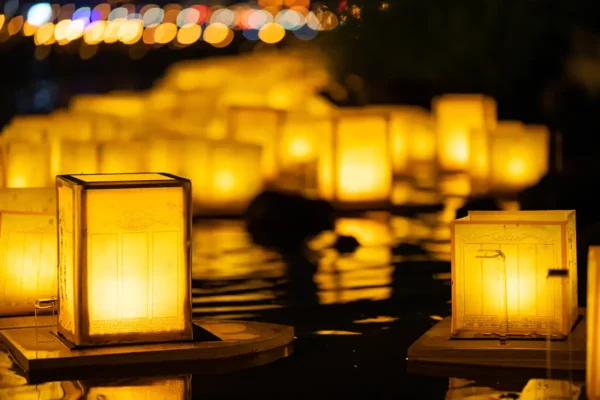
Obon, observed in mid-August, is a poignant blend of joyous celebration and solemn remembrance, deeply rooted in Buddhist beliefs. It’s believed that during Obon, the spirits of ancestors return to the earthly realm. This festival, dating back more than 500 years, is a time for families to come together, honor the spirits of their ancestors, and reflect on the continuity of life and death.
The festival’s highlight is the Bon Odori, a dance to welcome and entertain the visiting spirits. Each region of Japan has its unique dance style and music, ranging from the elegant to the lively. The dances often occur around a yagura (tower), with participants wearing traditional yukata and moving in a circle, symbolizing the cycle of life and death.
Another significant tradition is the Toro Nagashi, where lanterns are lit and set afloat on rivers, lakes, or the sea, symbolizing the guiding of ancestral spirits back to their world. The sight of hundreds of lanterns floating away into the night sky or across the water is both breathtaking and deeply moving.
The festival is also a time for mukae-bi and okuri-bi, the welcoming and sending off fires. Families light these fires at their homes to guide the spirits to and from the earthly world. Homes and graves are cleaned and decorated with offerings of food, flowers, and special Obon lanterns.
Obon is more than just a festival; it’s a profound cultural and spiritual observance that underscores the Japanese values of respect for ancestors, family bonds, and the impermanence of life. It’s a time of both joy and solemnity, where the living connect with the past, and the veil between the physical and spiritual worlds seems thinnest.
Sapporo Snow Festival (Winter)
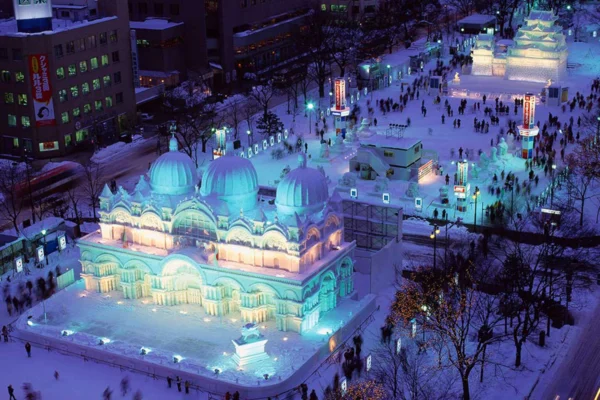
The Sapporo Snow Festival, held annually in February, transforms the city of Sapporo into a winter wonderland of snow and ice. Beginning in 1950 with just a few snow statues created by high school students, it has grown into an international event attracting millions of visitors from around the world. The festival takes place across several sites in Sapporo, with Odori Park, Susukino, and Tsu Dome being the main venues.
In Odori Park, the festival’s heart, visitors are greeted with a stunning array of large-scale snow sculptures, some measuring more than 25 meters in width and 15 meters in height. These magnificent works of art are not just visually breathtaking but also a testament to the skill and creativity of the artists. Themes range from famous landmarks, historical figures, to popular characters from movies and anime, showcasing a blend of traditional and modern culture.
At night, the sculptures are illuminated, creating a magical atmosphere that transforms the park into a luminous wonderland. Beyond the visual spectacle, the festival also features concerts, light shows, and projection mapping events, making it a feast for the senses.
Susukino, Sapporo’s entertainment district, hosts the Ice Sculpture Contest, where crystal-clear ice sculptures are displayed, shimmering like jewels under the lights. Tsu Dome, another site, offers a more interactive experience with snow slides, snow rafting, and a variety of snow activities, making it a family-friendly venue.
Exploring these must-see festivals offers a journey through the heart of Japan’s cultural heritage. Each festival is a unique kaleidoscope of sights, sounds, and emotions, inviting travelers to participate in age-old traditions that continue to enchant and inspire. Whether you’re dancing under cherry blossoms or marveling at ice sculptures, the festivals of Japan promise unforgettable experiences and deep insights into the nation’s soul. For more reading on Japanese Festivals: “Matsuri and Religion in Japan” in the Journal of Religion in Japan.
